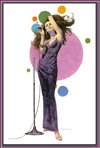A star of television and radio in the 1950s, she was well known in France. Among her roles were Lakmé, which she recorded for Decca Records in 1952 (with Georges Sébastian conducting), Lucia di Lammermoor, Olympia in The tales of Hoffmann, Gilda in Rigoletto, Rosina in The barber of Seville, and Leïla in Les pêcheurs de perles. In 1954, she went to San Francisco to sing Lucia and Gilda, and had a successful tour of the Soviet Union with sixteen concerts over a few weeks.
In 1935, Erna Sack made her first series of concert tours, to Austria, the Netherlands, France, and the United Kingdom. During the same year, she signed an exclusive recording contract with Telefunken. She appeared in the world premiere of Strauss's Die schweigsame Frau as Isotta, a role in which her special commitment earned her the gratitude of both Strauss and Karl Böhm. As a result, she was invited to sing the part of Zerbinetta under Strauss's personal direction when the Dresden State Opera visited the Covent Garden Royal Opera House in 1936.
From this point onwards Sack's career took off. She seemed to work tirelessly, at the opera, in concert tours, and touring, including to Rome where she appeared in Mozart's The magic flute with a cast that included Tito Schipa and Licia Albanese, Copenhagen, Oslo, and, for the first time, the United States, where she shared a platform at Carnegie Hall with Joseph Schmidt and Richard Tauber singing a duet from Lehár's The merry widow. After World War II, Sack toured extensively and was particularly successful in Latin America, especially Argentina, Uruguay, Chile, and Brazil. However, it was in Canada that she enjoyed her greatest post-war successes. She later toured South Africa and South-West Africa, and she returned to West Germany in 1950.
In 1953, she carried out an extended tour of the Federal Republic of Germany and West Berlin, a marathon undertaking involving over 40 concerts that was followed that autumn by a major tour of Australia and New Zealand. In the autumn of 1954 she celebrated her return to the United States which included a triumphant appearance at Carnegie Hall. She ended her concert career with one final tour of West Germany in the autumn of 1954, a concert at Constitution Hall, Washington, D.C. in 1956 and a brief tour of East Germany in 1957, and then withdrew from public life.
Listen to those extracts from Frühlingsstimmen ("Voices of spring") and Carnival of Venice and prick up your ears!
From this point onwards Sack's career took off. She seemed to work tirelessly, at the opera, in concert tours, and touring, including to Rome where she appeared in Mozart's The magic flute with a cast that included Tito Schipa and Licia Albanese, Copenhagen, Oslo, and, for the first time, the United States, where she shared a platform at Carnegie Hall with Joseph Schmidt and Richard Tauber singing a duet from Lehár's The merry widow. After World War II, Sack toured extensively and was particularly successful in Latin America, especially Argentina, Uruguay, Chile, and Brazil. However, it was in Canada that she enjoyed her greatest post-war successes. She later toured South Africa and South-West Africa, and she returned to West Germany in 1950.
In 1953, she carried out an extended tour of the Federal Republic of Germany and West Berlin, a marathon undertaking involving over 40 concerts that was followed that autumn by a major tour of Australia and New Zealand. In the autumn of 1954 she celebrated her return to the United States which included a triumphant appearance at Carnegie Hall. She ended her concert career with one final tour of West Germany in the autumn of 1954, a concert at Constitution Hall, Washington, D.C. in 1956 and a brief tour of East Germany in 1957, and then withdrew from public life.
Listen to those extracts from Frühlingsstimmen ("Voices of spring") and Carnival of Venice and prick up your ears!





No comments:
Post a Comment